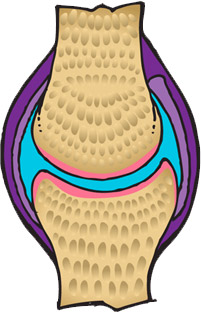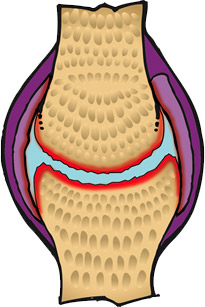Osteoarthritis Info
What is Osteoarthritis?
Healthy Joint

Inside a healthy joint, moving surfaces are covered by a layer of cartilage which stops two bone surfaces rubbing together and creating friction. Movement of the joint is made smoother still by the synovial fluid, which bathes the cartilage in lubricating molecules.
Osteoarthritic Joint

With osteoarthritis, the integrity of the joint is compromised.
The cartilage begins to wear thin, sometimes getting worn away completely, while the level of lubricating molecules in the synovial fluid and on the cartilage become depleted.
The degradation inside osteoarthritic joints contributes to inflammation, joint stiffness and pain upon movement. As the disease progresses, symptoms become more severe and debilitating, with pain sometimes becoming a permanent feature.

What are the causes of osteoarthritis?
Essentially, there are two types of osteoarthritis – Primary or Secondary. The key difference between these two types is down to the underlying cause.
Primary osteoarthritis
This type of osteoarthritis is associated with aging, affecting people aged around 55+ and is the result of wear and tear on your joints. The more you age, the more likely you will be affected by osteoarthritis. The Joints most commonly affected are knees, hands, the spine, and hips.
Secondary osteoarthritis
This type of osteoarthritis is likely to affect people who are predisposed to the condition through various means such as obesity, genetics, the result of another disease or previous trauma such as fracture or ligament rupture.
Treatment of osteoarthritis
There is no cure for osteoarthritis, but you can help relieve the symptoms by maintaining a healthy weight and regular exercise to keep active, build up muscle and retain joint mobility.
Painkillers
The type of painkiller (analgesic) your GP may recommend for you will depend on the severity of your pain and other conditions or health problems you have. The main medications used are described below.
Paracetamol
If you have pain caused by osteoarthritis, your GP may suggest taking paracetamol to begin with. This is available over the counter in pharmacies without a prescription. It is best to take it regularly rather than waiting until your pain becomes unbearable. However, when taking paracetamol, always follow the dosage your GP recommends and do not exceed the maximum dose stated on the pack.
Despite its popularity, recent study evidence has questioned the usefulness of paracetamol in treating osteoarthritis. Evidence published in the Lancet lead to the conclusion, “we see no role for single-agent paracetamol for the treatment of patients with osteoarthritis irrespective of dose”. The reference for this is Lancet 2016 Mar 17. pii: S0140-6736(16)30002-2.
Non-steroidal anti-inflammatory drugs (NSAIDs)
If paracetamol does not effectively control the pain of your osteoarthritis, your GP may prescribe a stronger painkiller. This may be a non-steroidal anti-inflammatory drug (NSAID). NSAIDs are painkillers that work by reducing inflammation. There are two types of NSAID and they work in slightly different ways:
- Traditional NSAIDs – such as ibuprofen, naproxen or diclofenac
- COX-2 inhibitors – often called coxibs – such as celecoxib and etoricoxib.
Some NSAIDs are available as creams (topical NSAIDs) that you apply directly to the affected joints and can be available over the counter, without a prescription. Some oral NSAIDs are available without a prescription. As well as helping to ease pain, they can also help reduce any swelling in your joints. Your doctor will discuss with you the type of NSAID you should take and the benefits and risks associated with it.
NSAIDs carry numerous warnings and must be taken with caution. They may not be suitable for people with certain conditions, such as asthma, a peptic ulcer or angina, or if you have had a heart attack or stroke. If you are taking low-dose aspirin, ask your GP whether you should use an NSAID.
Similarly NSAIDs can interfere with medications, for example negating the effect of most blood pressure medicines. You should always consult with your GP to see if NSAIDs are suitable for you.
